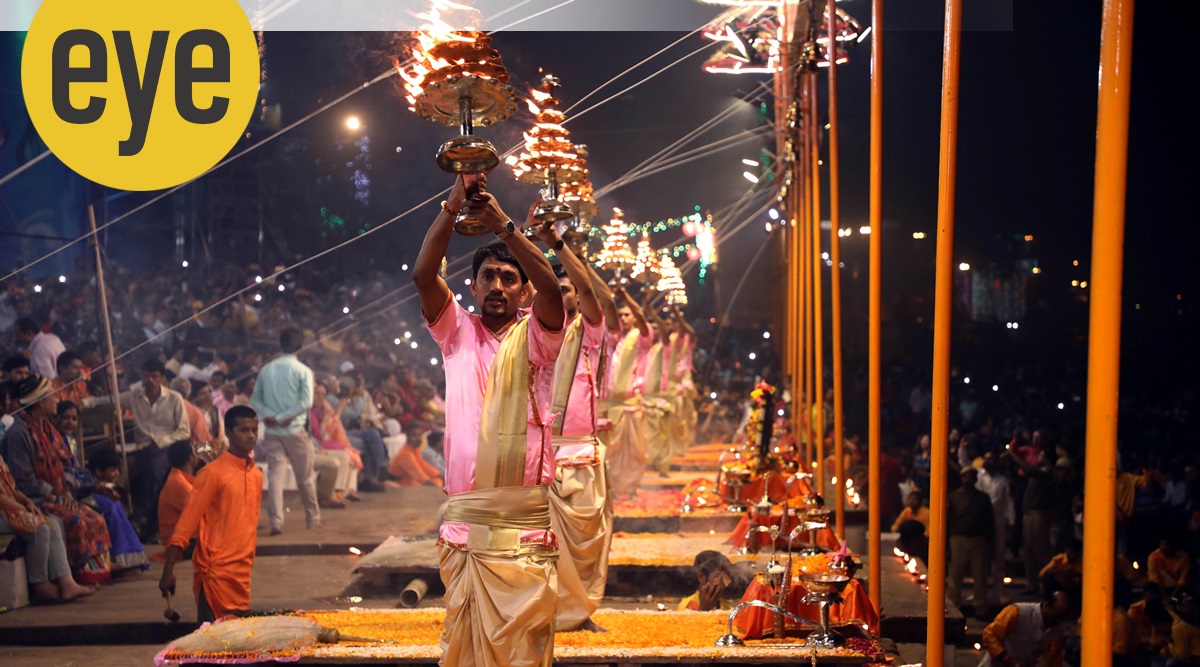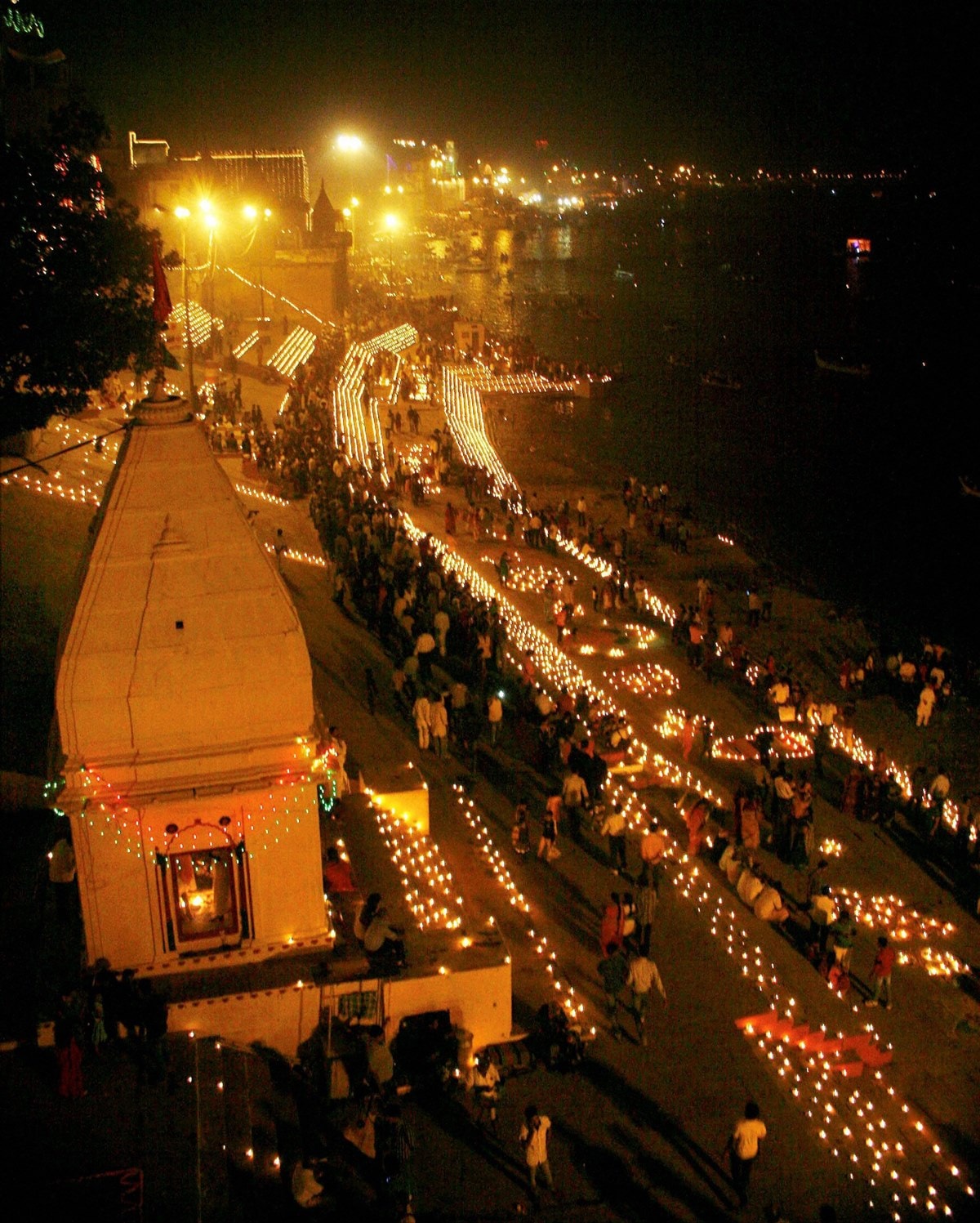 Dev Deepavali on Kartik Purnima during Ganga aarti in Varanasi (Credit: Anand Singh)
Dev Deepavali on Kartik Purnima during Ganga aarti in Varanasi (Credit: Anand Singh)Once, when shehnai maestro Ustad Bismillah Khan was asked about his routine in and affections for Varanasi — the city he’d lived in most of his life — he’d said, with a beedi between his fingers, “I roam the world, but it is Benares where my heart is… Ganga hai saamne, yahan nahayiye; iske masjid hai saamne, yahan namaz padiye; phir Balaji mandir chale gaye, vahan riyaz kiya… Ye aur kahin nahi milta (There is Ganga ahead, bathe here; there is a mosque across, read the namaz here, then one would go to Balaji temple for practice. I don’t get this anywhere else in the world).” His unconditional love for the city and its varied colours and deities surfaced in the famed Ram dhun, Tulsidas’s Raghupati raghav raja ram, manifested in the dulcet delivery on the shehnai. It also had within its gentle notes an understanding that while Varanasi’s ghats and gullies, music and food made space for religion, it was never entrenched in rigidity.
Khan’s statement about Varanasi, a place where people come to die and believers seek redemption, alludes to its syncreticity, its music, its culture and its people such as Khan. It echoes the ganga-jamuni tehzeeb, which, currently, in many other parts of the country, seems to be in peril or drowned in the din of debates and disputes over religion.
But come Diwali, Varanasi, soused in its Ganga maiyya refrain and the Purabiya lilt, comes alive with thousands of lamps and strains of music — bhajans, chaitis, thumris and kajris, which can be heard in various parts of the city. “It is not celebrated by one community. Diwali in Banaras is a festival for the Banarasis. You can go to any house in the city, and it will be bustling with activity around the festival,” says author and tabla player Pandit Kameshwar Nath Mishra, who accompanied Varanasi’s thumri matriarch, Girija Devi, for decades.
In a city that so doggedly holds on to the past, there are many lessons for the present. “Banaras has its own racha huya mahaul (quixotic ambience). Everything is done after immersing oneself in things. Nothing is on the surface. There is a saying: Humhu Banarasi, tumhu Banarasi (I’m a Banarasi, you are a Banarasi).
On Diwali, this spirit is on display even more,” says thumri singer Sunanda Sharma, who lived in Varanasi for over a decade, learning under the tutelage of Devi. “As musicians, while our day begins with praying to one’s instruments, a lot of our songs are about Ram and Sita, since the festival celebrates their return to Ayodhya. I significantly remember Siya sang jhoole bagiya mein Ram lalalna, a jhula (a folk form from Banaras, usually sung to describe scenes of Krishna and Radha on a swing). Then there are classical bandishes, as well, such as Beech nagariya, bhooli re dagariya, ab sudh lo mere Ram,” says Sharma, who recalls the shimmering diyas on the ghats and their reflection in Ganga while in a boat with “Appa ji (Devi)”.
 Devotees light diyas at Ganga Ghat in Varanasi (Credit: PTI)
Devotees light diyas at Ganga Ghat in Varanasi (Credit: PTI) It’s hard to miss the amalgamation of light, life, death and music all at once in a boat ride. “In that boat, there is a natural urge to sing of what you see. And the boatman, who mostly knows too much, will join you and invariably know the bhajan or chaiti, as well. There is something mesmerising about the whole experience. This, while the city continues its rhythm of life and death,” says Sharma.
When Mark Twain exclaimed that Varanasi is “older than legend, older than tradition… older than all of these put together,” it’s likely that it stemmed from the magic he experienced of the city, its sights and sounds, and this unique rhythm.
“When you celebrate Deepavali here, it’s an extension of the experience of the city itself. Together, it just multiplies,” says Mishra, who adds that 15 days after Diwali, Varanasi also celebrates Dev Deepavali, Diwali of the gods. It’s in memory of Shiva defeating Tripurasura, a trio of demon brothers. It’s believed that the gods took a dip in the Ganga — the heart of Varanasi — and then lit diyas everywhere. For over three decades now, people have been lighting diyas on the ghats.
Varanasi’s ghats are lit up with lakhs of lamps on the steps of the ghats that are yoked to those narrow, yet absolutely enchanting lanes. It’s in these slivers of streets where one is served the tastiest malaiyyo and the finest paan, besides, of course, kachori and jalebi.
One of the finest ways to “feel” Diwali is through a Diwali bandish — Pujat diwali, jagmag ujiyari… in raag Hamsadhwani, sung in kirana style, by Varanasi-based Pandit Chhannulal Mishra, who usually sings this ode to the festival of lights in concerts he attends around Diwali.
In November 1993, about a week after Diwali, Khan performed at the Queen Elizabeth Hall in London on the invitation from sitar maestro Ustad Vilayat Khan. In his speech, after the concert, describing the power of the seven notes and how they surpass every caste and creed that our nation concerns itself with, he spoke of his favourite city that he wasn’t born in, but lived and loved all his life. “Hum aisi jagah se aate hain jahan ras paida hota hai — Banaras (I come from a place, where rasa is born),” he said. Today, his soul and his shehnai rest under a neem tree in this city.